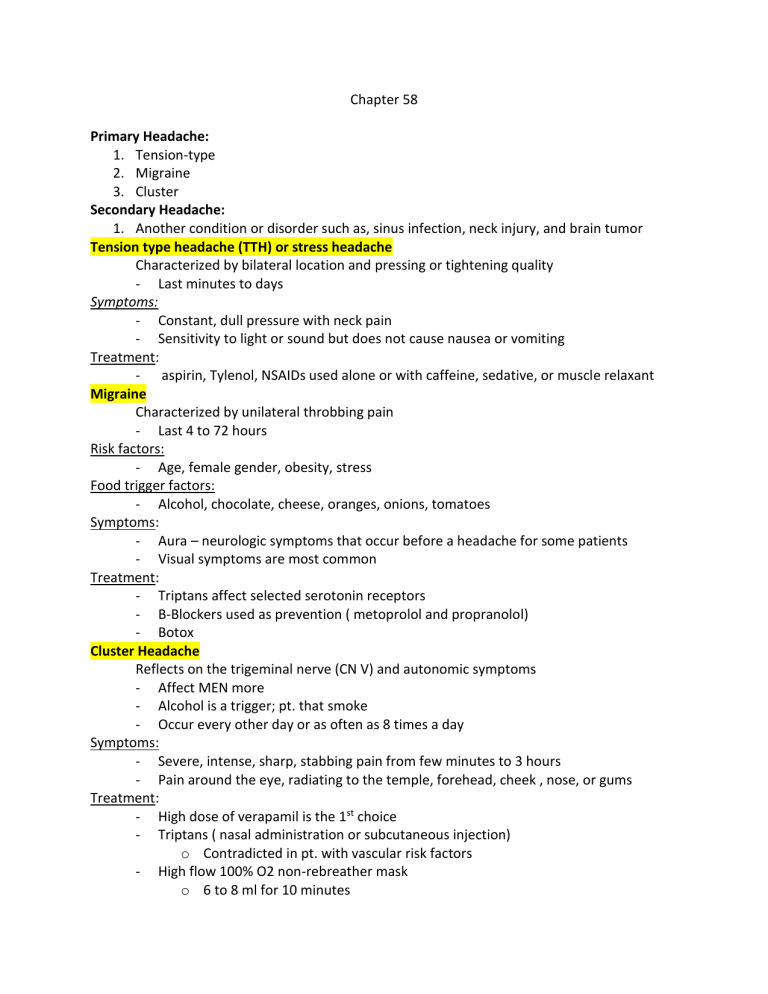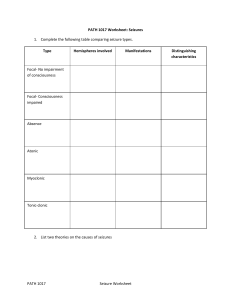
Chapter 58 Primary Headache: 1. Tension-type 2. Migraine 3. Cluster Secondary Headache: 1. Another condition or disorder such as, sinus infection, neck injury, and brain tumor Tension type headache (TTH) or stress headache Characterized by bilateral location and pressing or tightening quality - Last minutes to days Symptoms: - Constant, dull pressure with neck pain - Sensitivity to light or sound but does not cause nausea or vomiting Treatment: - aspirin, Tylenol, NSAIDs used alone or with caffeine, sedative, or muscle relaxant Migraine Characterized by unilateral throbbing pain - Last 4 to 72 hours Risk factors: - Age, female gender, obesity, stress Food trigger factors: - Alcohol, chocolate, cheese, oranges, onions, tomatoes Symptoms: - Aura – neurologic symptoms that occur before a headache for some patients - Visual symptoms are most common Treatment: - Triptans affect selected serotonin receptors - B-Blockers used as prevention ( metoprolol and propranolol) - Botox Cluster Headache Reflects on the trigeminal nerve (CN V) and autonomic symptoms - Affect MEN more - Alcohol is a trigger; pt. that smoke - Occur every other day or as often as 8 times a day Symptoms: - Severe, intense, sharp, stabbing pain from few minutes to 3 hours - Pain around the eye, radiating to the temple, forehead, cheek , nose, or gums Treatment: - High dose of verapamil is the 1st choice - Triptans ( nasal administration or subcutaneous injection) o Contradicted in pt. with vascular risk factors - High flow 100% O2 non-rebreather mask o 6 to 8 ml for 10 minutes Seizure Disorder ( epilepsy ) Causes: - Metabolic problems – acidosis, electrolyte problems, hypoglycemia, alcohol Extracranial disorders – lupus, diabetes, hypertension, sepsis, heart, lung, liver disease - Common cause during first 6 months = severe birth injury - after 50 years = stroke and brain tumor Different symptom seizures: 1. generalized onset o wide areas of both sides of the brain o impaired awareness for few seconds to several minutes 2. tonic-clonic seizure o patient loses consciousness and falls to the ground o body stiffens for 10 to 20 seconds, and extremities jerk for another 30 to 40 seconds o cyanosis, tongue or cheek biting, incontinence 3. Absence seizure o Only in children and rarely beyond adolescent o Brief staring spell like daydreaming then eye blinking or jerking in the lips o Lasts as much as 30 seconds 4. Focal onset seizures o Begin In 1 hemisphere of the brain o Sensory, motor, cognitive, or emotional manifestation based on areas o Described by the level of awareness Diagnosis: - Requires video-EEG monitoring - Magnetoencephalography to detect small magnetic fields of activity - CT or MRI for a new onset of a first seizure Complication: Status Epilepticus (SE) Continuous seizure activity without return to consciousness lasting longer than 5 minutes - Less likely to stop without drug therapy 1. Convulsive Status Epilepticus (CSE) a. Most common type b. With prolonged or repeated tonic – clonic seizures 2. Nonconvulsive Status Epilepticus a. Long repeated focal impaired awareness seizures b. Depends on the length and frequency of seizure 3. Refractory Status Epilepticus a. Continuous seizure activity despite first- and second-line therapy b. Carries high risk for mortality and neurologic damage Multiple Sclerosis Chronic, progressive, degenerative disorder of the CNS characterized by demyelination of fibers - Affect people of all ages; onset is usually between 20 and 50 years of age Symptoms: - Slow and gradual - First symptoms may be blurred or double vision, red-green color, blind in 1 eye - Lhermitte’s sign : sensory symptom as an electric shock goes down the spine - Severe, disabling fatigue - Spastic (uninhibited bladder) - Cognitive functions (short term memory, planning, visual perceptions) Drug Therapy: Immunomodulator drugs to modify progression and prevent relapse 1. B-1 interferon (Rebif, Plegridy, Avonex) 2. B-1b Interferon (Betaserom, Extavia) Mitoxantrone = antineoplastic medication with serious effects o Cardiotoxicity o Leukemia o Infertility Corticosteroids (methylprednisolone, prednisone) - Most helpful to treat acute exacerbations - Reduce edema & acute inflammation Amyotrophic Lateral Sclerosis (ALS) Rare progressive neuromuscular disorder marked by loss of motor neurons in stem and spine - Also known as Lou Gehrig’s Disease - Death can occur from compromised respiratory function due to muscle weakness and paralysis Classic signs: muscle weakness and atrophy but you WONT loose Cognitive function “bulbar onset” : Slurred speech or swallowing Riluzole (Rilutek) - Slow progression of ALS - Reduces damage to the motor neurons by decreasing the release of glutamate Edaravone (radicava) - Given IV daily for 14 days; followed by a 14-day drug free period Parkinson Disease (PD) Chronic, progressive neurodegenerative disorder characterized by: - Slowness in the initiation & execution of movement - Increased muscle tone (rigidity) - Tremor at rest & gait changes Environmental factors can increase the risk of development Symptoms: - First sign: tremors o More prominent at rest o Worsened by emotional stress or increased concentration - Rigidity o Increased resistance to passive motion when the limbs are moved through their ROM o Jerk quality - Akinesia o Absence or loss of control of voluntary muscle movement - Postural instability o Unable to stop themselves from going forward (propulsion) or backward (retropulsion) Drug Therapy Levodopa with Carbidopa (Sinemet) - Monitor for signs of dyskinesia - Monitor for adverse effects such as nausea or vomiting - Effects may be delayed for weeks to months - Do not give with food because it will reduce absorption Ropinirole (Requip) and Pramipexole (Mirapex) - Used alone or in combination with Sinemet - Extended-release form that improve ability to adhere to plans - Take with food to decrease nausea Surgical Therapy Used with pt. who are not responsive to drug therapy or who have developed severe motor complications Three categories: 1. Deep Brain Stimulation – deliver a specific current to the targeted brain location 2. Ablation (destruction) – finding, targeting, destroying an area of the brain affected 3. Transplantation Nutritional Therapy - Adequate fiber and fruit to reduce constipation - Eat 6 small meals a day; bite sized pieces - Limiting protein intake to the evening meal Myasthenia Gravis Autoimmune disorder of neuromuscular junction by weakness of skeletal muscles - Antibodies attack Ach receptors Symptoms: - Fluctuating muscle weakness of skeletal muscles such as muscles to move eyes, chew, swallow, speak, or breathe - Ptosis (drooping of the eyelids) - Facial mobility and expressions are affected Myasthenic Crisis - Acute worsening of muscle weakness triggered by infection, surgery, emotional distress, pregnancy, exposure to drugs - Results in aspiration, respiratory insufficiency, and respiratory tract infection Drug Therapy: - Anticholinesterase drugs - Alternate – day corticosteroids - Immunosuppressants ** Pyridostigmine (Mestinon) = most successful drug for long-term treatment of MG Surgical Therapy: - Removing the thymus gland can cause improvement in most patients because it enhances the production of AChr antibodies Huntington’s Disease Progressive, degenerative brain disorder that is genetically transmitted with an onset between ages of 30 to 50 years - Genetic testing confirms the disease of a person with symptoms Involved a deficiency of the neurotransmitters Ach and GABA Symptoms : movement disorder, cognitive, and psychiatric problems - Aspiration and malnutrition are likely as symptoms progress Drug Therapy: - Control movements and behavioral problems - Tetrabenazine (Xenazine) – used to treat the involuntary movements of chorea Caloric requirements are high - 4000 to 5000 cal./day to maintain body weight



